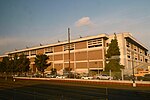Metro Headquarters Building
1990s architecture in the United States1995 establishments in CaliforniaBuildings and structures in Downtown Los AngelesGovernment buildings in Los AngelesOffice buildings completed in 1995 ... and 1 more
Skyscraper office buildings in Los Angeles

The Metro Headquarters Building (or One Gateway Plaza) is a 398 ft (121 m) high rise office tower in Los Angeles, California. It is located in Northeastern Downtown Los Angeles, east across the tracks from Union Station. Completed in 1995, it serves as the main headquarters for the Los Angeles County Metropolitan Transportation Authority.
Excerpt from the Wikipedia article Metro Headquarters Building (License: CC BY-SA 3.0, Authors, Images).Metro Headquarters Building
East Cesar E Chavez Avenue, Los Angeles Downtown
Geographical coordinates (GPS) Address Website External links Nearby Places Show on map
Geographical coordinates (GPS)
| Latitude | Longitude |
|---|---|
| N 34.056444444444 ° | E -118.23294444444 ° |
Address
Los Angeles County Metropolitan Transportation Authority Headquarters
East Cesar E Chavez Avenue One
90012 Los Angeles, Downtown
California, United States
Open on Google Maps











